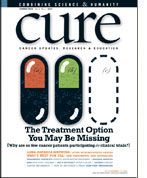Publication
Article
CURE
ASCO Updates
Author(s):
Updates from the annual meeting of the American Society of Clinical Oncology.
The annual meeting of the American Society of Clinical Oncology was held in Chicago from June 4 to June 8. The gathering attracted more than 25,000 cancer researchers, physicians, and representatives from pharmaceutical and biotechnology industries to learn the latest in cancer care, treatment, and prevention. Details can be found at www.asco.org or ASCO’s patient website, www.cancer.net.
A new chemotherapy drug, called eribulin, extended survival by two and a half months in patients with locally recurrent or metastatic breast cancer whose cancers continued to progress despite treatment with numerous other drugs. The phase 3 study marks the first time a single agent has helped these patients live longer, said researchers.
Two-thirds of the 762 patients in the clinical trial received eribulin, a drug derived from a sea sponge, and the remaining third received another round of treatment chosen by their physician. Because no standard exists, researchers wanted the control arm to reflect real-life choices offered to these women.
Patients on eribulin lived a median of just over 13 months compared with 10.7 months for women in the treatment of physician’s choice of chemotherapy arm. The most common side effects of eribulin included fatigue, low white blood cell count, and peripheral neuropathy.
Eisai, the maker of eribulin, filed for approval of the drug in March for locally advanced or metastatic breast cancer that has been previously treated with at least two chemotherapy regimens. The Food and Drug Administration has since granted priority review for the application, meaning the agency will decide by September whether to approve the drug.
Contrary to popular belief, men with high-risk or locally advanced prostate cancer can benefit from radiation therapy with few significant long-term effects. Interim results from a phase 3 trial showed that radiation added to androgen-deprivation therapy (ADT) increased overall survival and decreased the risk of death from prostate cancer.
After a seven-year follow up, 74 percent of patients who had radiation were alive compared with 66 percent on ADT alone. Researchers also concluded that the risk of prostate cancer death dropped by 43 percent compared with hormone therapy alone (from 26 percent to 10 percent). Overall survival increased by six months. Side effects were modest and included diarrhea and rectal bleeding.
Radiation has not been the standard treatment for this population due to the unknown benefit and potential side effects. With such significant results, however, radiation in combination with ADT should now be a standard of care, said lead researcher on the trial, Padraig Warde, MBChB, head of radiation oncology at the University of Toronto’s Princess Margaret Hospital. Final study data are expected in 2012, but researchers predict the results will hold, estimating a 15 percent risk of prostate cancer death compared with 23 percent with ADT alone.
Anthony D’Amico, MD, PhD, professor of radiation oncology at Harvard Medical School, who led the discussion following Warde’s presentation, said prostate cancer, even when it’s high-risk or locally advanced, is still a long-term disease, and patients who have other, more significant health issues may decide to forego radiation.
For metastatic melanoma patients who were out of treatment options, the immune system-targeted drug ipilimumab extended their lives by nearly four months compared with an investigational vaccine called gp100.
The phase 3 study randomly assigned 676 patients with metastatic melanoma that had progressed during prior therapy to one of three arms: ipilimumab alone, gp100 alone, or ipilimumab plus gp100. In patients receiving ipilimumab alone, median overall survival reached 10.1 months, compared with 6.4 months for those receiving gp100 alone. Adding gp100 to ipilimumab didn’t improve survival, which was 10 months for the combination. Twenty-four percent of patients continued to benefit from ipilimumab for at least two years, compared with 14 percent for gp100.
“We’ve never had a drug show survival benefit in metastatic melanoma,” lead researcher Steven O’Day, MD, of The Angeles Clinic and Research Institute in Los Angeles, told CURE at the meeting. “It’s not only impacting median [survival], but it’s impacting long-term survival. And now we have patients on this trial out as far as four and a half years still alive.”
The most common side effect of ipilimumab was diarrhea, although up to 15 percent of patients experienced other severe side effects related to autoimmunity, such as rash and inflammation of the colon. Bristol-Myers Squibb, the maker of ipilimumab, plans to file the drug for approval in pretreated metastatic melanoma later this year.
“It’s not only impacting median [survival], but it’s impacting long-term survival.“­
When it comes to treating elderly cancer patients with chemotherapy, the prevailing thought has been “less is more” because of potential health risks associated with treatment side effects. And, although most non-small cell lung cancer patients are at least 65 years old and nearly a third are over 70, elderly patients are usually excluded from lung cancer clinical trials and are either not treated at all or treated with a more gentle single chemotherapy agent as opposed to the standard combination that includes a platinum drug.
At ASCO’s plenary session, a large randomized study contradicted that notion in advanced non-small cell lung cancer when data showed that the standard combination chemotherapy, usually given to younger patients, was effective and safe in elderly patients. More than 450 patients aged 70 to 89 were treated with either one chemotherapy drug (vinorelbine or gemcitabine) or a combination of carboplatin and paclitaxel. The overall survival of patients strongly favored the combination (6.2 months versus 10.3 months), with one-year survival improving from 26.9 percent on the single agent to 45.1 percent with the combination. Progression-free survival nearly doubled to 6.1 months.
While the regimen was considered safe, neutropenia, or low white blood cell count, was more common in the combination arm. The study was stopped early when interim results showed a significant benefit with the combination arm. Elisabeth Quoix, MD, professor of medicine at University Hospital in France, predicted that the results will create a paradigm shift in the treatment of elderly lung cancer patients.
Continued use of the targeted drug Avastin (bevacizumab), after initial treatment with the drug and chemotherapy, helped slow progression of advanced ovarian cancer, according to a phase 3 study.
Nearly 1,900 newly diagnosed patients with advanced epithelial ovarian, primary peritoneal, or fallopian tube cancer were randomly assigned to receive chemotherapy alone (paclitaxel plus carboplatin), chemotherapy plus Avastin, or chemotherapy plus Avastin followed by maintenance therapy with Avastin for up to an additional 10 months.
Women in the maintenance group showed no worsening of their disease for about four months longer than those who received chemotherapy alone (14.1 months versus 10.3 months). Median progression-free survival reached 11.2 months for patients receiving chemotherapy plus Avastin.
Researchers said the study represents the first time that an angiogenesis inhibitor—a drug that blocks the development of blood vessels that promote tumor growth—has been found to delay disease progression in this patient population. Whether long-term use of Avastin helps women live longer is still to be determined.
Side effects of Avastin, a drug currently approved for colorectal, breast, brain, lung, and kidney cancers, include high blood pressure and low white blood cell counts.
An investigational drug, Crizotinib (PF-02341066), which targets a newly discovered gene mutation in lung tumors, showed dramatic results in a small phase 1 clinical trial of metastatic non-small cell lung cancer patients. Of the 82 patients evaluated in the trial, almost 87 percent responded to the treatment, with responses lasting from 1 to 15 months. Patients are still being followed, but the probability of the disease not progressing by the six-month mark was 72 percent, and 77 percent are still on therapy.
Researchers were surprised to see such a positive response to the single-agent treatment, especially because most patients had progressed on several different regimens. Crizotinib was also well tolerated with about half the patients experiencing only mild side effects, including diarrhea and vomiting. ALK-positive lung tumors, which make up about 4 percent of lung cancers, tend to be adenocarcinomas and are found in never smokers and younger patients. Researchers are planning two follow-up trials for lung cancer patients who test positive for ALK and have been previously treated.





